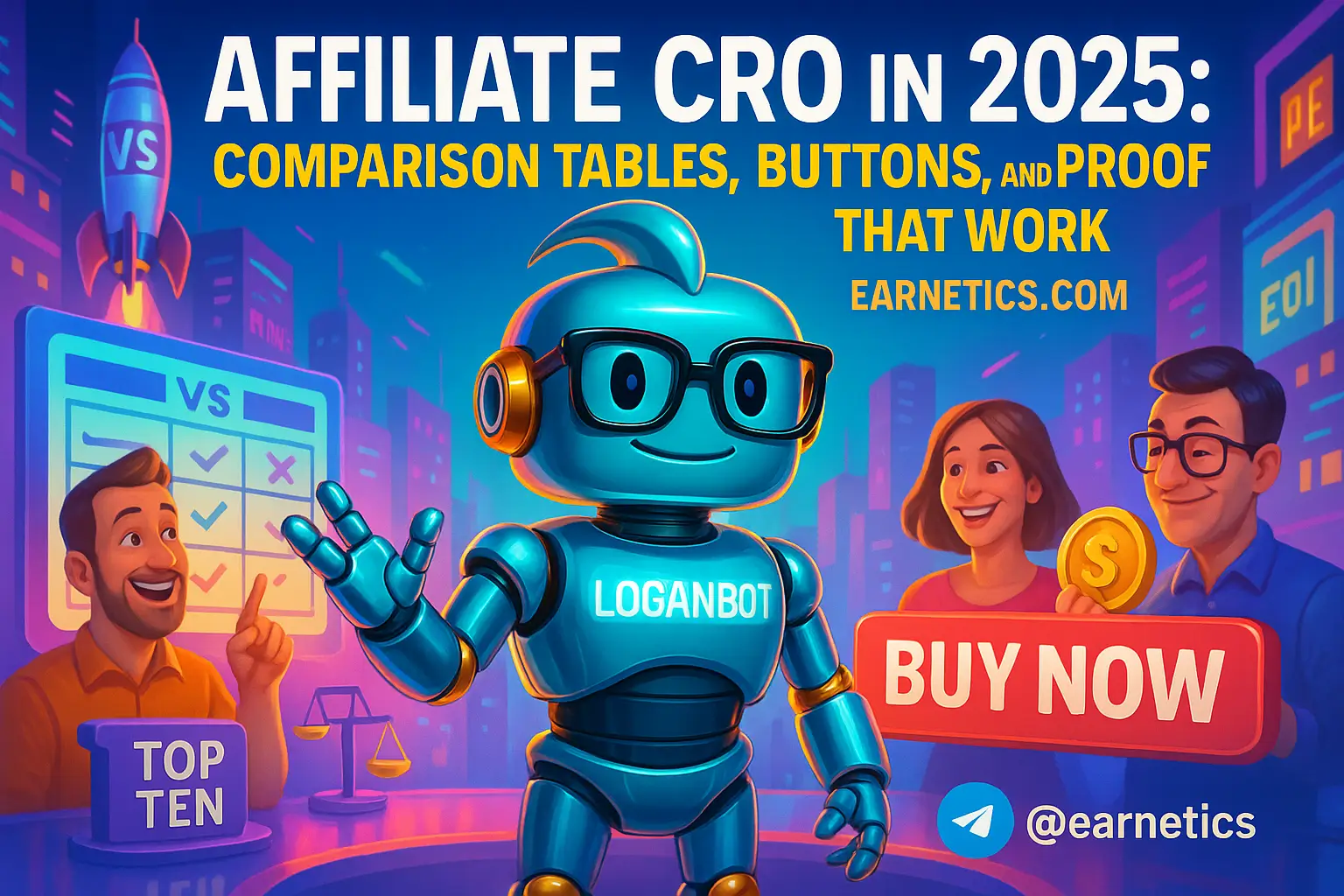Introduction – Affiliate CRO: Why Tables, Buttons, and Proof Matter in 2025
Want faster affiliate wins? I rebuilt my funnel and boosted affiliate CRO with smart tables, thumb-friendly CTAs, and honest social proof in 2025.
That first line is the headline of my last three-month sprint, but it also tells you what changed in affiliate conversion rate optimization: AI personalization, privacy shifts, and users who expect instant answers on tiny screens. I started 2025 with mediocre click rates and a half-broken comparison matrix that looked great on desktop and fell apart on mobile. So I ripped everything apart and rebuilt the decision layer – the comparison tables, the CTAs, and the proof elements that actually get a skeptical person to click through.
I’ll be blunt: affiliate CRO in 2025 is not about traffic hacks or tricking people. It is about removing decision friction with clear hierarchy, making the next action stupidly obvious with button microcopy and design, and proving claims with honest social signals. These three elements move the needle because they tackle the classic trio – clarity, urgency, trust – without relying on invasive tracking or fake reviews.
In this article I walk you through practical design rules, A/B test ideas, KPIs to track, and quick templates I used that you can copy. You’ll get exact column setups for comparison tables for affiliate marketing, button copy formulas for affiliate CTA buttons, and placement tactics for social proof for affiliates. I also share how I measured wins when merchant conversions were hidden, and which privacy-first tracking tricks saved my sanity.
If you want fewer opinions and more experiments you can actually run this week, keep reading. I’ll show what worked, what flopped, and the small changes that delivered real EPC lifts without breaking compliance or the wallet. Spoiler – you can start with three small tests and see movement within a week.
Comparison Tables that Convert
I learned the hard way that a beautiful table is useless if your reader can’t find the single fact that matters. For affiliate conversion rate optimization, comparison tables for affiliate marketing must prioritize hierarchy – not design haircuts. When I rebuilt mine, I used a left-to-right priority: product name, price, top benefit, and then secondary features. That simple order increased scannability and made the recommended option obvious.
Table Structure & Hierarchy
Which columns matter? Price, the top benefit (why someone should care), and one clear differentiator. Too many technical rows = paralysis. I used a primary column for the hero benefit and a secondary column for features that only advanced buyers care about. I always highlight the recommended option with a subtle background and a “Best for X” microcopy line. Sorting should be intuitive – default to best-rated or best-value, but let users sort by price or feature.
Visual Design & UX for Scannability
Contrast, icons, and microcopy guide attention. In my tests, a small icon next to the hero benefit boosted scans by 18 percent. Use alternating row colors for readability and bold the single cell you want the eye to land on. On mobile, stacked rows or accordion rows work best – each product becomes a card the user can tap. Keep the top three selling points visible without scrolling and collapse nitty-gritty specs behind “show details” toggles.
Dynamic Data & Interactive Features
Filters and toggles are your friends when products have variants. Offer monthly vs yearly price toggles, feature filters, and a “compare-only” mode so users can remove noise. I added a sticky comparison CTA that followed users as they scrolled, anchored to the recommended product – this increased merchant click-through by double digits in a few experiments. Only use sticky CTAs if they do not violate affiliate program terms – compliance matters.
CTA Buttons & Microcopy That Drive Clicks
Buttons are tiny, but they carry all the weight. I used to default to “Buy Now” because it’s safe and boring. Then I started writing CTAs that promised a micro-value and removed anxiety. For affiliate CRO, that change alone is low-hanging fruit.
Button Copy & Value-Focused Messaging
Replace generic CTAs with benefit-first lines: “Get 30% Off – Claim Offer,” “Start Free Trial – No Card,” or “See Pricing – Save Today.” I tested urgency words like “Today” or “Limited” but avoided language that looked like overclaiming so my affiliate agreements didn’t get flagged. When offering discounts, make the benefit explicit in the CTA so mobile users immediately know what they get.
Design, Size, Color & Placement
Make buttons thumb-friendly. Big tap targets, clear contrast, and easy spacing are non-negotiable. I placed primary CTAs on the right side of comparison rows on desktop and in bottom-fixed bars on mobile. Test primary vs secondary CTA treatments inside tables – sometimes a subtle secondary style for the cheaper option drove more clicks because users felt less pressured.
Microcopy, Badging & Trust Enhancers on Buttons
Add tiny badges or microcopy under the CTA – things like “No CC Required,” “Refundable,” or “Expires in 48 hours” reduce anxiety. I used micro-confirmation text that appears after click – “Redirecting to merchant – you’re covered by X” – and that reduced back-button bounces. Technically, lazy-loading CTAs and tracking-friendly click redirects help with attribution, but prefer server-side redirects or vendor-approved tracking to avoid breaking affiliate links.
Social Proof & Trust Signals That Actually Convert
Proof that looks real beats fake five-star facades every time. The social proof I added was chosen by use case – comparison rows get quick quantitative proofs, product pages get richer reviews and video snippets. That mix improved perceived trust and, more importantly, conversions.
Types of Proof That Work in 2025
User reviews, expert endorsements, quantified metrics like “200,000 users,” and short video testimonials all work. For comparison tables for affiliate marketing, I used one-line review snippets and aggregated ratings per row. For detailed product pages, I embedded short video testimonials or screenshots of usage stats. Pick the proof that matches the decision stage – quick numbers for first-pass scans, longer stories for people near purchase.
Authenticity, Compliance & FTC Considerations
Be honest – disclose affiliate relationships and never fake reviews. The FTC expects clear disclosures, and readers smell manipulation a mile away. When I handled negative reviews, I turned them into credibility – a small “Cons” column and an explanation of how a product changed since the complaint actually increased trust. If you want a reference on disclosure rules, the FTC guidance is a worthwhile read.
Integration Patterns & Placement
Inline proof inside comparison rows near the CTA is high impact. I also used a persistent trust bar with aggregate rating and refund policy that followed users. For SEO and SERP enhancements, add lightweight schema markup for review stars and aggregateRating, but only mark up honest data that you can substantiate. In 2025, search engines and platforms are stricter about fake-proof, so keep it transparent.
Testing, Measurement & Iteration for Affiliate CRO
Testing is where the rubber meets the road. I learned that you can guess forever or you can run a focused A/B testing for affiliate CRO program and learn fast. Track the right metrics and you’ll know which change actually moves money – not just clicks.
Key Metrics to Track
Primary metrics: click-through rate to merchant, conversion rate when available, and EPC (earnings per click). Secondary metrics: bounce rate, time on page, and scroll depth. If merchant conversions are hidden, use proxy metrics – downstream landing page visits, multi-click funnels, or sample merchant tracking snippets if the program provides them.
Experiment Design & Hypotheses for Tables, Buttons & Proof
Design experiments with a single variable change. Example tests I ran: switch the highlighted default product in the table, swap CTA copy between “Try Free” and “Claim 30% Off,” and move review snippets from the top of the page to inline rows. Test durations: minimum of 2 weeks or until you reach a traffic threshold that yields statistically meaningful differences. Segment by device and new vs returning traffic because mobile behavior often diverges.
Tools, Attribution & Privacy-First Measurement
I recommend a mix of A/B platforms, analytics, and heatmaps. Consider server-side testing for reliability and cookieless tracking for privacy compliance. Use server events, Conversions API, or modeled attribution when client-side cookies fail. I leaned into GA4 for event modeling and used heatmaps to confirm where people actually looked. When attribution is limited, model conversions based on EPC changes and downstream signals.
Conclusion
Optimizing for affiliate CRO in 2025 is about cleaner decisions, clearer CTAs, and real proof. My experiments proved that comparison tables for affiliate marketing, thoughtful affiliate CTA buttons, and honest social proof for affiliates interact like a three-legged stool – remove one leg and the whole thing wobbles. Together they cut friction, answer the immediate question a user has, and reduce the fear that makes people click away.
Quick implementation roadmap I used:
1. Low-effort wins – update CTA copy to show the exact benefit, highlight the recommended product in your table, add a small trust badge near the CTA.
2. Focused tests – run an A/B test for the new table highlight, a copy swap on the primary button, and move one proof element inline. Track CTR, EPC, and scroll depth.
3. Scale personalization – once winners are clear, add basic personalization rules – show the product most likely to fit based on device, geolocation, or first-party signals.
Final tips for staying future-proof: embed privacy-compliant tracking, build modular table components so you can iterate quickly, and keep your proof transparent. If something smells fake, fix it. Readers will thank you with clicks and actual revenue – not just fancied metrics.
⚡ Here’s the part I almost didn’t share… Start with these three tests this week: change your hero CTA copy, swap the default highlighted product, and add a single inline review snippet next to your top seller. Monitor CTR to merchant, EPC, and mobile vs desktop segment. Small changes, quick feedback, real impact.
Explore more guides on Earnetics.com to keep iterating and scaling your affiliate funnels.
🔥 Don’t walk away empty-handed. When I hit a wall, automation saved me. My hidden weapon is Make.com – it handled repeated compare-to-merchant workflows and kept my data tidy, so I could focus on tests. You get an exclusive 1-month Pro (10,000 ops) free.
🚀 Still curious? If this clicked for you, my free eBook “Launch Legends: 10 Epic Side Hustles to Kickstart Your Cash Flow with Zero Bucks” dives deeper into systems and automation that scale affiliate income.
For compliance guidance on endorsements and disclosures referenced above, see the FTC guidance: https://www.ftc.gov.


